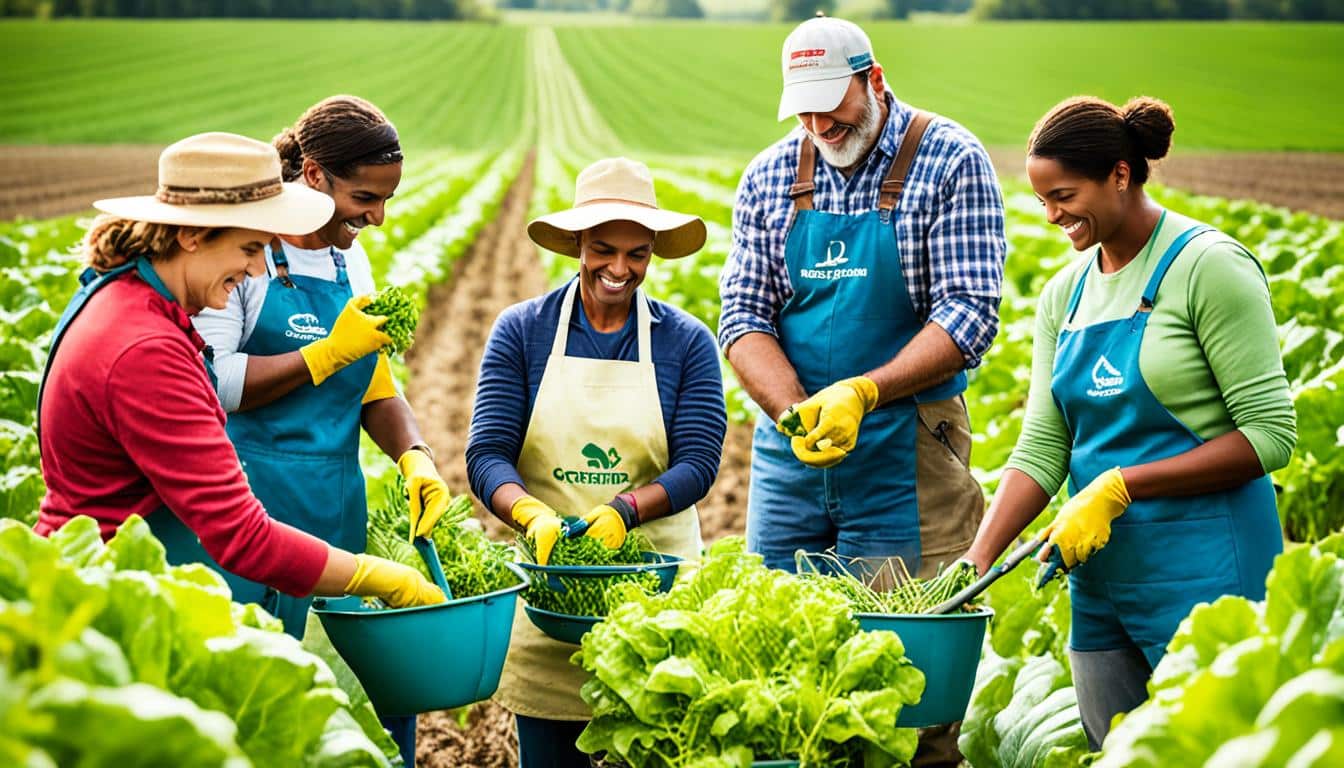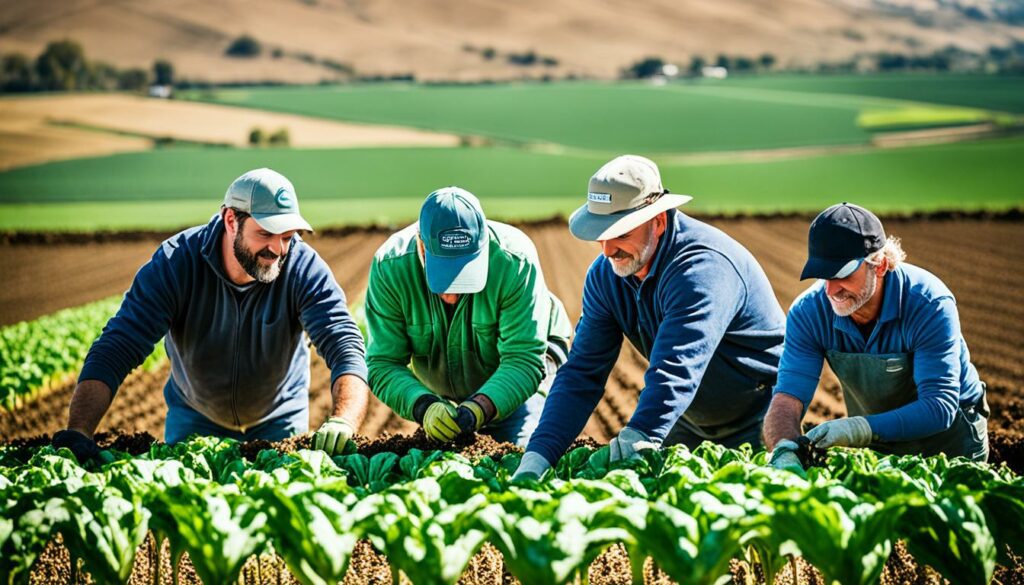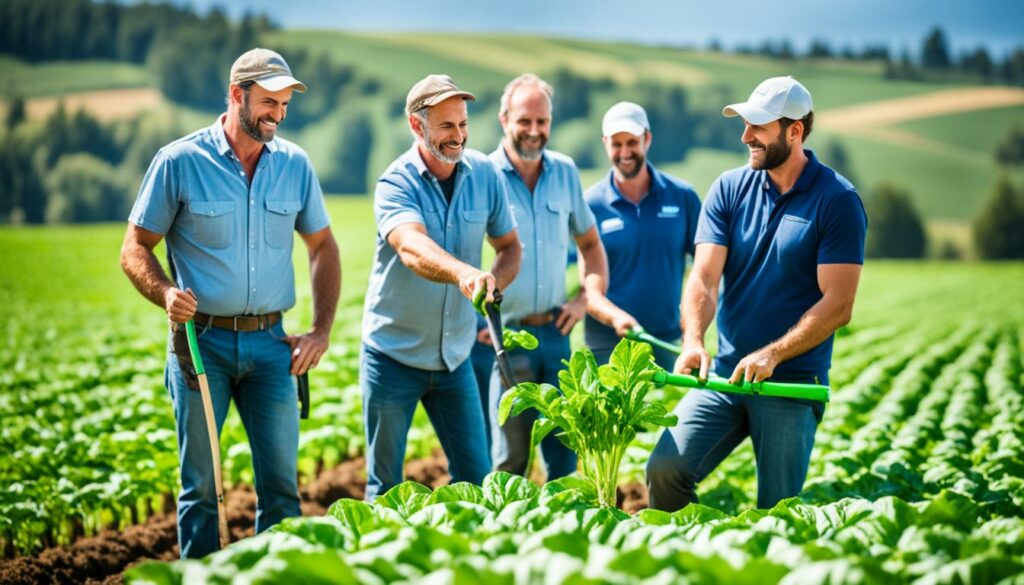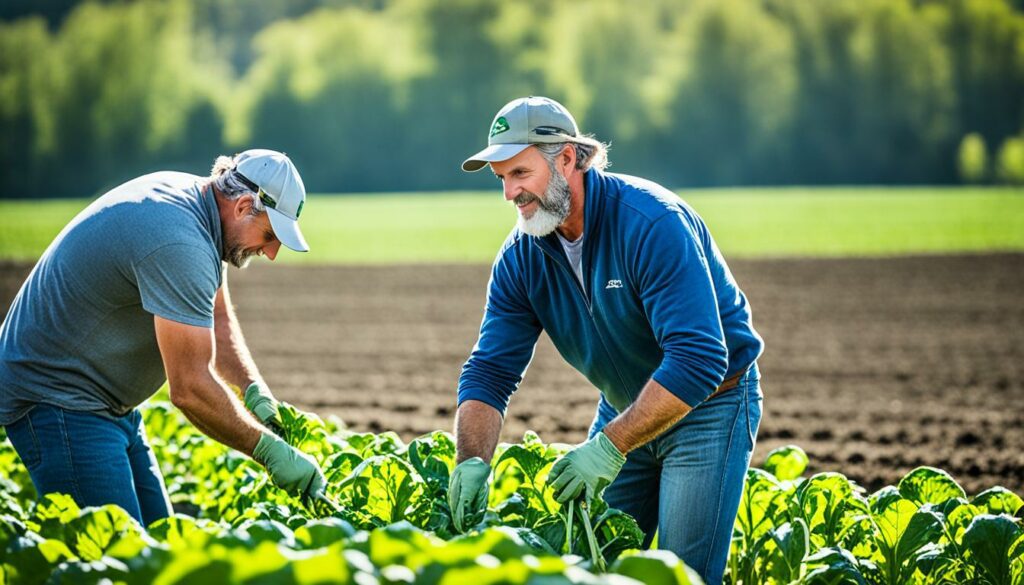Menu

Did you know there are over 1.2 million farming co-ops worldwide? This shows how popular cooperative farming has become. It’s where farmers come together, combining their skills, knowledge, work, and tools. They do this to help each other succeed. Cooperative farming relies on working together, making agreements, and trusting each other. This helps them share risks, cut costs, and access markets better.
By joining forces, farmers get to use shared wisdom, ways to sell their produce, and business contacts. This teamwork makes their farms stronger and more profitable. But, there are also hurdles, such as disagreements, how to split profits, and running the cooperation. Overcoming these is an important part of making cooperative farming work well.
Cooperative farming is a unique method where farmers join forces. They share land, tools, and knowledge to reach common goals. This way, farming becomes more about working together and making choices as a group. It leads to better and more eco-friendly ways of farming.
The big advantage of collective farming is using resources better and producing more. When farmers team up, they can afford bigger and better equipment. They can also learn and use new farming methods. This sense of working together makes everyone feel part of something important.
For farmers with small or medium-sized farms, shared farming is a game-changer. It helps them lower risks and share costs. For example, groups in the U.S. made about $1.3 billion in 1976 thanks to working together. This shows how much more can be achieved by pooling resources.
Cooperatives also help farmers sell their products better. A company in Arkansas, called Riceland Foods, paid its group 40 cents more per hundredweight of rice. This was more than what other rice farmers in the U.S. got. So, farmers can make more money through cooperatives.
The financial seeds of cooperatives show how important they are. In 1979, the average farm invested $6,423 in such ventures. This shows the significant support they provide. They really lessen the load for farmers.
In short, cooperative farming not only boosts the economy but also strengthens farming communities. It does this by offering economic collective farming benefits and shared farming benefits. These lead to lasting success and improvement in farming.
The rich cooperative farming history began during the Industrial Revolution. This time showed massive economic and social changes. In England from 1750 to 1850, farmers in Europe started what we call today cooperative farming. Small farmers joined forces against the bigger farms. They shared resources, which led to the birth of cooperative farming. The Rochdale Society of Equitable Pioneers in 1844 marked the start of modern cooperatives.

In the United States, cooperative farming also has a fascinating story. Benjamin Franklin started the first one – a fire insurance company – in 1752. Soon, dairy and cheese cooperatives began in 1810. This marked a change in food production. The American Farm Bureau and the National Farmers Union were big in the 1900s. They helped grow cooperative farming. By 1866, urban areas saw consumer cooperatives.
| Key Event | Date | Impact |
|---|---|---|
| First U.S. Cooperative Business | 1752 | Founded by Benjamin Franklin, introduced mutual aid |
| First Dairy and Cheese Cooperatives in the U.S. | 1810 | Initial steps towards food production collaboration |
| Consumer Cooperatives in Industrial Towns | 1866 | Expanded cooperative principles into urban areas |
| CLUSA Formation | 1916 | Promoted comprehensive cooperative agenda |
| First Credit Union Statute | 1909 | Massachusetts legislation supported financial cooperatives |
The Cooperative League of the United States of America (CLUSA) started in 1916, a key moment in cooperative farming history. It pushed for many cooperative efforts. The Sherman Antitrust Act helped by blocking unfair competition against cooperatives.
The benefits of collaborative agriculture are global. In the 1870s, Denmark led in cooperative marketing without much government help. Today, big names like Florida’s Natural and Ocean Spray in the U.S. show the power of cooperatives. As of 2017, NCBA CLUSA worked with over 400,000 farmers worldwide. This collaboration is increasing yields and improving market access, showing the success of cooperative farming.
When we look at different cooperative farming structures, we see a wide variety. From simple agreements between friends to complex businesses, each type has its own benefits. These structures bring farmers together to work as a team. They help increase productivity and make farming more sustainable. This shows how modern agriculture welcomes different approaches.
Neighbours often team up informally, especially in small farming communities. Without the need for legal contracts, they might share tools or help with big jobs. These cooperative farming structures rely on trust and the willingness to lend a hand. Even though they’re not formal, they’re easy to start and appealing to those wanting to help each other.
Incubator farms offer a stepping stone for newbies in agriculture. They provide land, tools, and a way to sell products. This helps beginners learn and grow their farming without huge start-up costs. A great example is Canada, where rural cooperatives help launch the careers of over 1,200 farmers every year.
Farmers might opt to lease land together, especially in pricey areas. This way, they share the costs of owning land, reducing the financial burden. They can work together while still running their own operations. Such arrangements are a smart move where buying land outright isn’t an option.
Then, there are the big players like cooperatives and partnerships. These are serious, binding agreements among farmers. They share not just the work but the rewards too. Models like User-Benefits ensure everyone has a voice and gains from their hard work. In the U.S., these formal cooperative farming structures made over $22 billion in 2020. That’s a huge impact.
Working together in cooperative farming brings big positives. One key advantage is resource sharing. This is very important for everyone involved.
The sharing economy in agriculture means people share labour, knowledge, and tools. It also includes using shared land and buildings. This sharing saves a lot of money. In 1976, companies working together saved $1.3 billion. This was 21% of their total investment. These figures show how powerful cooperative farming benefits can be when people work together.

Another advantage is getting into bigger markets together. Working as a group, farmers can get better prices for what they sell. For example, Riceland Foods paid its members more than the average farmer. They got 40 cents extra for each hundredweight of rice and 35 cents more for each bushel of soybeans. This shows how farming cooperatively opens doors to better deals and markets.
Reducing risks is a major benefit. When risks are shared, farming becomes more stable. In 1976, collective savings were 7.1% of the total income of U.S. farmers. This shows how farming together makes a big difference. Also, each farmer’s average investment was $6,423 in 1979. This investment underlines the crucial role cooperative farming plays in keeping farms secure and steady.
Agricultural cooperatives vary, meeting different farming needs. Each sector, like supplying or marketing, offers unique help. They serve farmers, helping them in various ways to be more successful. This variety shows how cooperatives boost the farming world.
Supply cooperatives are key for farmers, selling seeds, and equipment. They buy in bulk, getting big discounts. In places like Minnesota and Iowa, USA, farmers save money this way. They also get top-quality supplies.
Marketing cooperatives sell what farmers grow, getting them good prices. They can negotiate as a group to find the best deals. Riceland Foods in Arkansas pays its growers high prices for rice and soy. This is great when the time of sale and how it’s stored affects the price.
Service cooperatives give farmers help with repairs, financial advice, and more. They might be few, but they’re very important. In Canada, 1,200 service cooperatives help local farmers. They make sure even small farms get the support they need.
The table below shows how these cooperatives differ:
| Cooperative Type | Main Function | Key Benefits | Geographic Example |
|---|---|---|---|
| Supply Cooperatives | Providing farming inputs | Cost savings through bulk purchasing | Midwestern U.S. (e.g., Minnesota, Iowa) |
| Marketing Cooperatives | Selling member produce | Higher sale prices through collective bargaining | Riceland Foods, Arkansas |
| Service Cooperatives | Offering diverse support services | Enhanced productivity and sustainability | Rural Canada |
The different types of cooperatives cover many farming needs. They create a strong system, helping farming be more efficient and competitive.
Cooperative farming is key in fostering rural agricultural development. It helps farmers improve their market competitive ability. By working together, they cut down on costs and boost product quality. In 1979, farmers across the U.S. had put $16.9 billion into cooperatives. This shows how important cooperatives are for farming success.
In the same year, 5,900 cooperative groups made about $1.3 billion in profit. This shows the financial benefits of working together. Farm credit cooperatives also saw profit with $369 million and $334 million each in two years. It shows how communal agriculture advantages individual farming and its wider community.

Riceland Foods, for example, paid its members a premium price for their produce. This led to farmers earning more, which is good news for rural agricultural development. Net margins of $388 million and $340 million by electric cooperatives brought better services to rural areas.
| Year | Net Margins ($ Million) | Number of Coops |
|---|---|---|
| 1976 | 1,300 | 5,900 |
| 1977 | 334 | N/A |
| 1978 | 369 | N/A |
| 1978 | 388 | Rural Electric Coops |
| 1977 | 340 | Rural Electric Coops |
| 2020 | 22,200 | Agricultural Inter-cooperation |
Farming cooperatives not only help with agriculture but they also build communities. They offer shared services like healthcare, education, and infrastructure. With over 1.2 million such groups globally, they greatly support rural agricultural development. In the U.S., states such as Minnesota and California highlight the success of this model.
Over 2,100 U.S. cooperatives, uniting 2 million farmers, earned $22.2 billion in 2020. This and the employment of over 250,000 workers show how cooperative farming boosts rural areas. In Argentina, rural cooperatives look after 80% of all farmlands, showing the model’s success and growth.
Two farms, Urban Edge Farm and Elmer Farm, are great examples of what shared farming can achieve. They show how working together can bring success to everyone involved.
Urban Edge Farm in Rhode Island is a hub for new farmers. It provides land, tools, and support for those starting out. This way, new agricultural workers can begin their journey with less cost. They find a supportive place to grow and innovate.
“Urban Edge Farm gives new farmers a firm foundation to improve their skills and stand on their own,” a farming expert confirms.
Elmer Farm in Vermont offers a fascinating story. Starting as a shared project, it now runs independently. This move to self-sufficiency underlines the lasting benefits of cooperative farming. It proves that together, farms can grow and succeed.
The financial gains from cooperative farming are substantial. In 1976, cooperatives earned a net margin of $1.3 billion. This made up 21% of their members’ contributions. Such cooperatives also accounted for 7.1% of U.S. farmers’ entire income that year.
In 1979, farmers’ investments in cooperatives reached $16.9 billion. For each farm, this averaged $6,423. These figures show how financially rewarding cooperative farming can be.
Throughout the world, cooperative farming is a popular model. There are over 1.2 million farming cooperatives globally. In Argentina, they manage more than 80% of farmland. This proves their key role in the agriculture sector.
In the U.S., inter-cooperation in agriculture made a huge impact in 2020. It generated $22.2 billion, showing the economic power of teamwork.
However, cooperative farming also faces difficulties. Twin challenges are the low use of advanced technologies and member disputes. These, along with other challenges, can stand in the way of success.
But the stories of Urban Edge Farm and Elmer Farm are uplifting. They showcase how cooperative farming boosts not just farming but also economic growth. By working together and learning from each other, these farms inspire others in the cooperative farming community.
Shared resources are crucial in cooperative farming. Farmers team up to use the sharing economy in farming better. They aim to boost productivity, cut costs, and promote green methods. Now, let’s look at the key parts of shared resources that keep cooperative resource management strong.
Cooperative farming lets folks share their labour and equipment. This way, they spend less individually and get work done fast. They also make sure their tools and workers stay busy, unlike when only one person owns them.

Sharing land and infrastructure lowers the entry bar for new farmers. They get to use barns, storage, and more with others. It cuts the cost of starting up and makes better use of these places.
Sharing knowledge and skills is a huge plus of cooperative resource management. Veterans teach newbies about farming, offering new ideas and green methods. This sharing culture boosts learning and innovation for everyone in farming.
Cooperative agriculture brings many economic benefits of cooperative farming. It gives farmers an advantage in the tough agricultural market. By working together, farmers can cut costs and make more profit. Let’s look at how they do this with lower costs and higher profits.
Farming cooperatives can lower their costs significantly. They buy things like seeds and machinery in bulk. This leads to big agricultural cost savings. Also, they can get better prices with their big buying power.
For example, over 1.2 million cooperatives globally have shown they can reduce costs. In the U.S., cooperatives made $22.2 billion in 2020. This shows the big savings and strength of farming together.
Working together also increases profit margins. Without middlemen, cooperatives can sell their products at better prices. In Argentina, more than 80% of farms work in cooperatives, making farming more profitable.
Cooperatives also help market in bigger areas, stabilizing prices. Sales through marketing are often the biggest in cooperatives. This shows the financial value of farming together.
The table below outlines the statistical advantages across various cooperative farming arenas:
| Region/Country | Key Contribution | Economic Impact |
|---|---|---|
| Worldwide | 1.2 million cooperatives | Popular model in the sector |
| United States | Inter-cooperation | $22.2 billion generated in 2020 |
| Canada | 1,200 rural cooperatives | Widespread organisational presence |
| Argentina | 80% farmlands managed by cooperatives | Significant role in the agricultural sector |
In the end, cooperative farming boosts income by spending less and selling smarter. It offers agricultural cost savings and better performance. This helps farmers stay strong around the world for a long time.
Cooperative farming does a lot more than earn money. It changes and improves community life in important ways. It leads to better unity and closer local relationships. This happens as people work together on farms in a group effort.

Cooperative farming is key to building communities. There are more than 1.2 million farming groups around the world. This shows the power of bringing people together for shared farming goals.
Places like Minnesota and Iowa show how important these groups are in rural areas. When people farm together, they learn to work better as a team. They improve their communication and problem-solving skills. This makes the community a tighter and more supportive place.
Cooperative farming also improves life quality for many involved. Working together means better money plans and marketing. This leads to less financial worry and stress. Plus, it offers fresh local food to the members. This boosts health and wellbeing.
Groups like Citizen Farmer teach about farming that protects the earth. This spreads awareness and skills to care for the land. Passing this knowledge on helps farming communities last for the future.
Cooperative farming offers various benefits. However, it also brings challenges like disputes, shared liabilities, and management conflicts. These aspects are important to think about.
Disagreements are common in collective farming. They often arise from how profits are shared and decisions are made. Involving multiple people makes aligning interests difficult. Also, sharing profits fairly can generate tension.
Cooperative members share financial risks. This is because they are responsible for debts together. Back in 1979, farmers collectively invested $16.9 billion in their cooperatives. Although pooling resources can reduce costs, it also means everyone faces risks together. This can lead to conflicts.
Management disagreements are another big issue. These can be about how to market or farm. Last year, cooperatives faced problems like low prices and high costs. Such economic challenges make management conflicts worse. This happens as cooperatives work together to overcome these issues.
Dealing effectively with the collective farming difficulties is key. This requires strong governance and clear communication. By addressing these challenges, the cooperative farming model can be truly beneficial.
Legal frameworks are crucial in cooperative farming. They ensure operations run smoothly and are fair. These rules support sharing resources like skills, labour, and land for everyone’s gain. They also protect and empower all members.
These laws form the backbone of how co-op members interact. They clearly outline each person’s rights and duties. This stops arguments and issues over who does what or gives what. Such structure is vital for different types of cooperatives, ensuring everyone works towards common goals.
Laws also help with money matters, like fairly sharing profits and avoiding debts. They make sure every member gets an equal say, no matter how much they’ve invested. This keeps decision-making democratic and helps solve disputes peacefully, keeping the co-op stable.
In short, the legal side of cooperative farming is key to its survival and growth. It builds a foundation of trust and fairness among members. This lets farming projects thrive, overcoming challenges and reaching their goals together.
Cooperative farming means farmers come together and share things like skills, labour, and tools. This way, they work as a team to help each other out. It helps them save money, reduce risks, and get better chances in the market.
Teamwork in farming has lots of benefits. It lets farmers use each other’s resources, get to more markets, and face fewer risks. Working together makes them more efficient and helps the environment too.
It started when small farmers needed ways to compete against big farms. They joined forces to get the benefits of working in a larger group. This way, they could tackle big challenges better together.
There are many ways farmers can work together, from informal to formal groups. They might help each other out as neighbours, form a cooperative, or share a partnership. There are also unique setups for supporting new farmers and sharing land.
By working together, farmers help their local economy and cut costs. They can improve the quality of their produce and enjoy support from the community. This way, everyone gets access to better services and the place becomes a nicer home for all.
Look at places like Urban Edge Farm in Rhode Island and Elmer Farm in Vermont. They’re great examples of how co-ops help farmers start and grow their businesses. Such successful examples show the power of working together.
In cooperative farming, members might share their work, tools, land, and buildings. They also pass on knowledge and skills to each other. This sharing is key to making sure everyone does well.
Working together cuts down on costs, like buying items in bulk or sharing sale channels. This leads to saving money and making more profit. It’s good for the farmers and their business.
Farming together helps build stronger communities. It brings people closer, where they share their goals and support each other. This improves everyone’s life and work in the area.
There can be problems like disagreements over money and who makes the decisions. Also, everyone in the cooperative might be asked to help cover any big debts. Differences in how the farm should run can also cause trouble.
Laws are crucial to make sure a cooperative runs smoothly and fairly. They protect everyone by laying out rules, handling issues, and making sure profits are shared justly. Legal rules make sure everyone knows what to expect and can help solve problems.